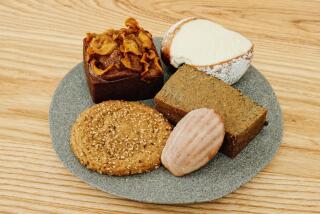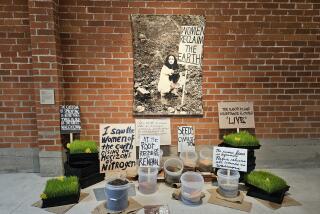Asian style and taste
- Share via
FOOD IS OUR DAILY BREAD — or rice, as the case may be. It is also tradition, community and culture. In the exhibition “Banquet: A Feast for the Senses” at the Pacific Asia Museum, 14 Asian and Asian American artists reflect on the topic, coming up with some unexpected contemporary takes. Instead of servings of sushi, there are servings of bead-encrusted fake sushi in the sculpture of Kohei Nawa. Instead of platters of roast duck, there are platters of multiplied body parts in the computer-generated photographs of Sang-Bin Im. Instead of jars of kimchi, there’s a split-screen video by Susan Lee-Chun on how to make kimchi -- well, sort of.
“ ‘Banquet’ in Asia has many meanings; you often think of happier associations, “ says Chip Tom, the Los Angeles-based independent curator who organized the show, “but I didn’t want the show to be predictable -- filled with pictures of food and big parties.” Instead, he approached the artists -- mostly in their 20s and 30s, from the U.S., China, Korea and Japan -- and asked them to think about food in a larger context, especially as it relates to family, religion, gender issues and assimilation.
The artists came back with responses using photography, painting, sculpture, assemblage and video. Eight created works specifically for the show.
Several built on established conventions. For instance, Chinese American artist Zhi Lin’s large painting “Starvation” has a vertical format, with a banner draped over it, the way a painting or calligraphy might be honored in a traditional Chinese household. However, he uses Western painting techniques to depict an imagined scene from the Qing Dynasty: people feasting in public while starved prisoners in cages and pillories are forced to watch. This work about public torture was painted in 1999, and, Tom says, was the artist’s response to the Tiananmen Square massacre.
Similarly, Ambreen Butt, a Pakistani American, employs a style from a tradition she was born to: a miniaturist painting style harking back to Mughal art. But instead of depicting scenes from Hindu epics dominated by male heroes and gods, she’s created her own alternate universe in her “Cirque du Monde” series, in which women appear as creators and sustainers of the cycle of life. (Three works from the series are included in the exhibition.)
Playing on the familiar to get at the more unexpected is a shared strategy. Chiho Aoshima of Japan uses a manga style for her 16-foot-long chromogenic print “Sublime Grave Dweller Shinko.” The center of this tableau is dominated by the ghostly figure of Shinko, a Japanese spirit who resides in cemeteries to ingest the nasty souls of the dead and transform them, cleaned up, into moths. However, here she’s becoming a tad deformed as a result. To the left of her cemetery is a sylvan paradise where no human treads, while to the right, on the other side of a dividing wall, is a young delivery woman who has crashed off her bicycle. The bowl of noodles she was supposed to have delivered is now atop her head. A stark, modern city is behind her.
“The artist is trying to deal with women’s issues,” Tom explains. “She’s witnessing these forlorn women in Japan; the society has weighed them down.”
The associations to food are even more abstract in “Paper Menagerie Series,” an installation by New York-based Korean artist Jung Eun Park. In it, a collection of pastel-hued, fantastical forms that look like discarded fruit peels or exploded basketballs takes over a wall.
Park creates each piece through a laborious process of first cutting and coloring the shapes, then hand-punching the texture all over the surface. “The form of my works came from the shape of foods like fruits, vegetables, fishes,” she writes by e-mail during a recent visit home. “I mix them and transform them into a new creature.”
She points out that eating is always a collective idea in her native country; it is built into the language. “We call family ‘Shik-goo’ in Korean,” she says. “ ‘Shik’ means ‘to eat’ and ‘goo’ means ‘a mouth’. Therefore ‘Shik-goo / family’ means a mouth to eat together, people eating together.” Park likes to think of her pieces as part of that meal.
Not all of the works deal with food in such elliptical terms. Korean American artist Susan Lee-Chun’s video “Work in Progress (Kimchi),” shot from overhead like a cooking show, is an intriguing, sometimes hilarious, recording of the process used to make the pickled cabbage.
Lee-Chun, who grew up in Chicago, remembers having kimchi with every meal. “Even when my sister and I made pasta, my parents would ask, ‘Where’s the kimchi?’ ” the artist says by telephone from Miami, where she now lives. “Even at Thanksgiving, it’s on the table.”
But until Lee-Chun did this project, she had never attempted making it, always relying on her mother to do so. Last summer, on a visit home, she asked her mother to demonstrate on camera; in the video, this is shown on the right-hand side of a split screen. On the left, the artist places her own amateur hands trying to repeat the steps -- and her clumsiness makes it all too clear that making kimchi takes far more than a recipe.
“The whole time my mother was wondering how this would become an art project, how by my re-contextualizing it and putting it in a museum it would become something else,” Lee-Chun says. “After she saw it, she was still saying, ‘Oh, you’re doing that wrong!’ ”
*
‘Banquet: A Feast for the Senses’
Where: Pacific Asia Museum, 46 N. Los Robles Ave., Pasadena
When: 10 a.m. to 6 p.m. Wednesdays through Sundays
Ends: Feb. 4
Price: $7, adults; $5, students, seniors; free, children 11 and younger.
Info: (626) 449-2742, www.pacificasiamuseum.org
More to Read
The biggest entertainment stories
Get our big stories about Hollywood, film, television, music, arts, culture and more right in your inbox as soon as they publish.
You may occasionally receive promotional content from the Los Angeles Times.










